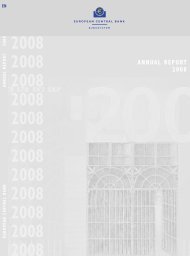Reserve Bank of Australia Annual Report 2011
Reserve Bank of Australia Annual Report 2011
Reserve Bank of Australia Annual Report 2011
You also want an ePaper? Increase the reach of your titles
YUMPU automatically turns print PDFs into web optimized ePapers that Google loves.
appropriate fee; the committed amount would cover the shortfall between an ADI’s liquid asset holdings and<br />
the regulatory requirement (see chapter on ‘Operations in Financial Markets’). The <strong>Reserve</strong> <strong>Bank</strong> has been<br />
working with APRA on finalising the details <strong>of</strong> how the facility would work, including its pricing and the range<br />
<strong>of</strong> assets that would be eligible as collateral.<br />
The BCBS has also worked, at the request <strong>of</strong> the FSB, on developing a methodology for identifying global<br />
systemically important banks, and for determining the size <strong>of</strong>, and instruments to be used for, the additional<br />
capital that such institutions will be required to hold. A consultation paper outlining this methodology was<br />
released by the BCBS in July <strong>2011</strong>. A senior manager from Financial System Group has been involved in the<br />
Macroprudential Supervision Group <strong>of</strong> the BCBS that has undertaken much <strong>of</strong> this work.<br />
Committee on Payment and Settlement Systems (CPSS)<br />
The CPSS serves as a forum for central banks to monitor and analyse developments in payment and settlement<br />
infrastructures and set standards for them. The primary focus <strong>of</strong> the CPSS over the past year has continued to<br />
be the setting <strong>of</strong> international standards for financial market infrastructures. In conjunction with the Technical<br />
Committee <strong>of</strong> the International Organization <strong>of</strong> Securities Commissions (IOSCO), the CPSS released a draft <strong>of</strong><br />
the new Principles for Financial Market Infrastructures in March <strong>2011</strong> for consultation. The principles seek to<br />
consolidate, update and strengthen existing standards for systemically important payment systems, central<br />
counterparties and securities settlement systems, and extend their coverage to trade repositories. The<br />
principles also incorporate specific guidance for infrastructures serving OTC derivatives markets. The Head <strong>of</strong><br />
Payments Policy Department is a member <strong>of</strong> the Steering Group undertaking the review, and the department<br />
also continues to contribute to specific work streams. The final principles are expected to be published in<br />
early 2012.<br />
A key issue arising from the work on the new principles, along with the ongoing reform <strong>of</strong> OTC derivatives<br />
markets, is how to achieve fair and open access to central-clearing services. The <strong>Reserve</strong> <strong>Bank</strong> has been<br />
engaged in this work from an early stage through its membership <strong>of</strong> the OTC Derivatives Regulators’ Forum, an<br />
international group that provides regulators with a means to co-operate and share information in relation to<br />
OTC derivatives, central counterparties and trade repositories. Questions <strong>of</strong> access to central-clearing services<br />
are now being addressed by two complementary working groups, one under the CGFS and another under the<br />
CPSS and IOSCO. Payments Policy Department continues to be involved in this ongoing work.<br />
The <strong>Reserve</strong> <strong>Bank</strong> is also participating directly in two further working groups: a CPSS working group on<br />
innovation in retail payments; and a joint CPSS–BCBS working group considering settlement risk in foreign<br />
exchange transactions.<br />
International Monetary Fund (IMF)<br />
The IMF has continued to play a prominent role in the international response to the lessons <strong>of</strong> the financial<br />
crisis. In the past year, the IMF has provided a substantial amount <strong>of</strong> financial assistance to its members. There<br />
has also been ongoing reform in areas such as governance and surveillance.<br />
In 2010/11, the most prominent forms <strong>of</strong> assistance to IMF members were the loan facilities provided to Ireland<br />
and Portugal and the ongoing assistance to Greece. These lending packages were organised in conjunction<br />
with the European Union, with the IMF providing around one-quarter <strong>of</strong> the €85 billion pledged to Ireland and<br />
one-third <strong>of</strong> Portugal’s €78 billion assistance package. This followed the IMF’s contribution <strong>of</strong> €30 billion to the<br />
May 2010 assistance package for Greece.<br />
To ensure that the IMF has adequate resources to cover members’ future financing needs, the Executive Board<br />
approved an enlargement <strong>of</strong> the New Arrangements to Borrow (NAB). Under the expanded NAB, a total <strong>of</strong><br />
SDR 211 billion (around US$335 billion) was made available, if required, to supplement the resources from<br />
members’ subscription payments (quotas) to the Fund.<br />
38 <strong>Reserve</strong> bank <strong>of</strong> <strong>Australia</strong>





![KNOW YOUR NEW GIBRALTAR BANKNOTES - [Home] bThe/b](https://img.yumpu.com/50890985/1/184x260/know-your-new-gibraltar-banknotes-home-bthe-b.jpg?quality=85)
![PAPUA NEW GUINEA - [Home] - Polymer Bank Notes of the World](https://img.yumpu.com/49758743/1/190x143/papua-new-guinea-home-polymer-bank-notes-of-the-world.jpg?quality=85)










